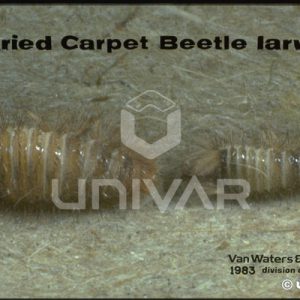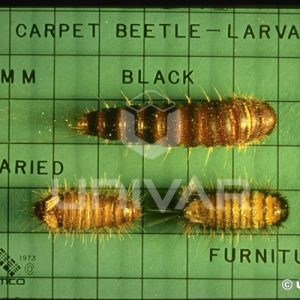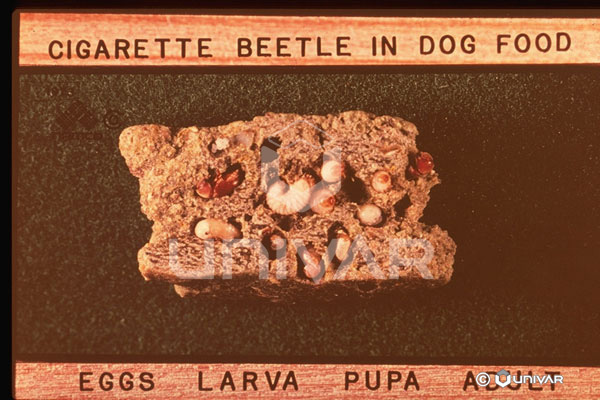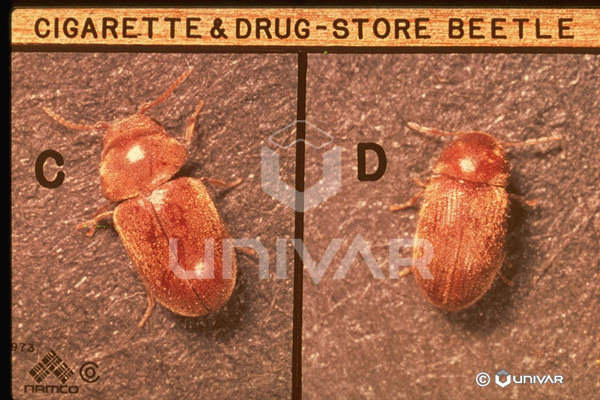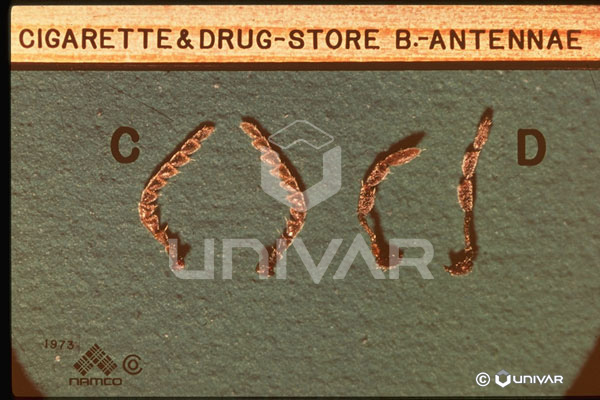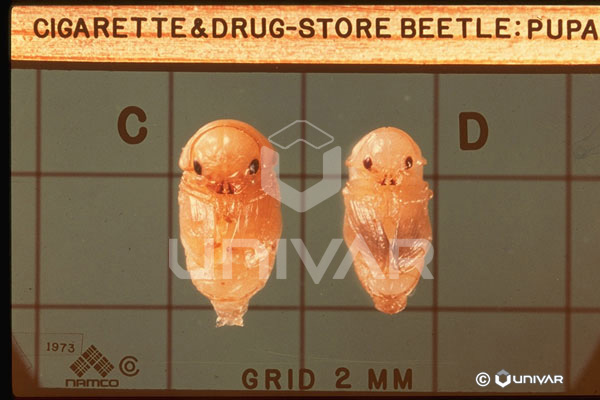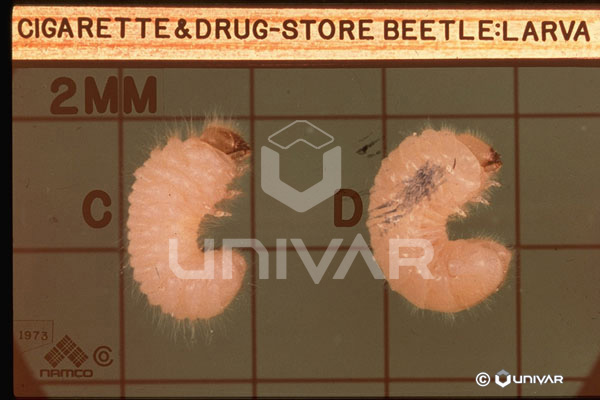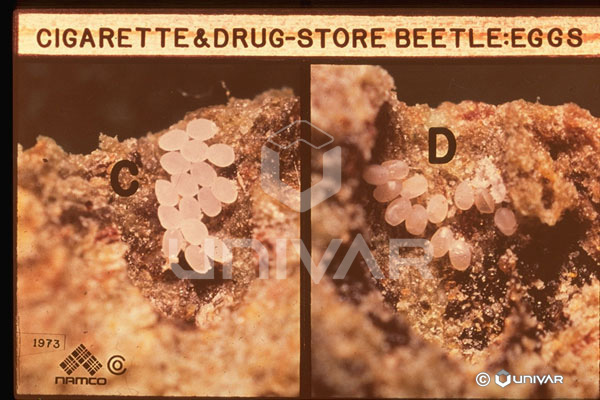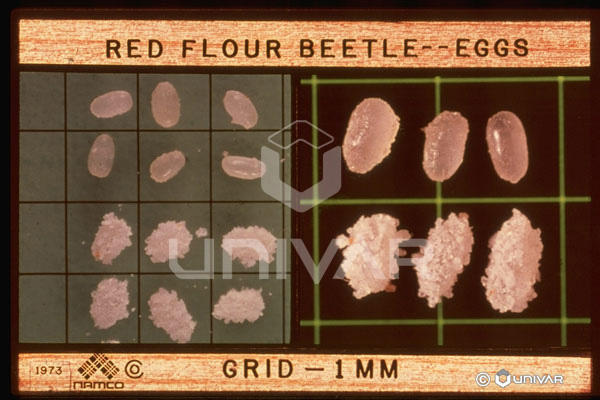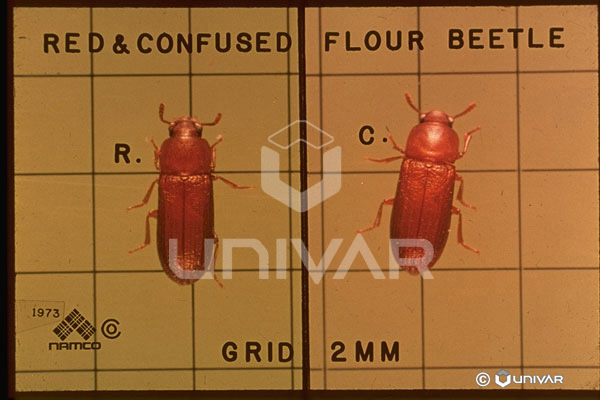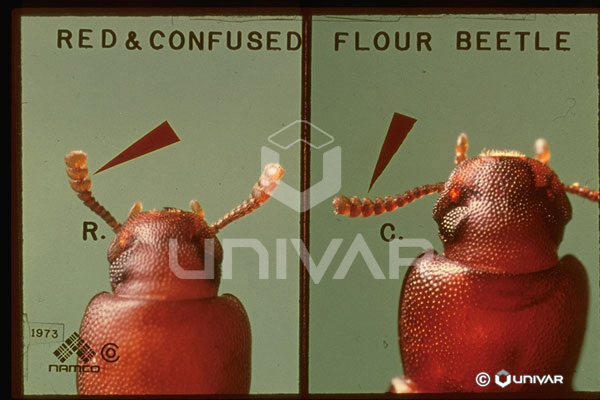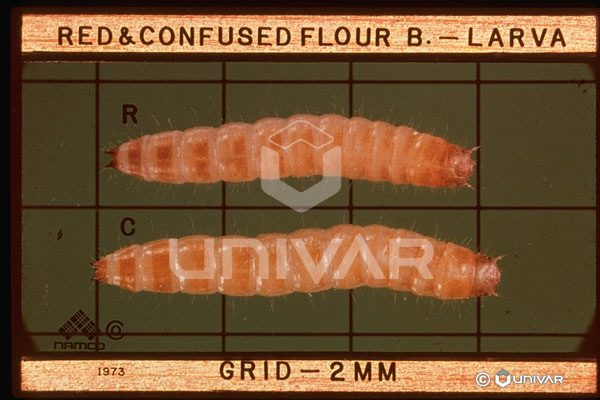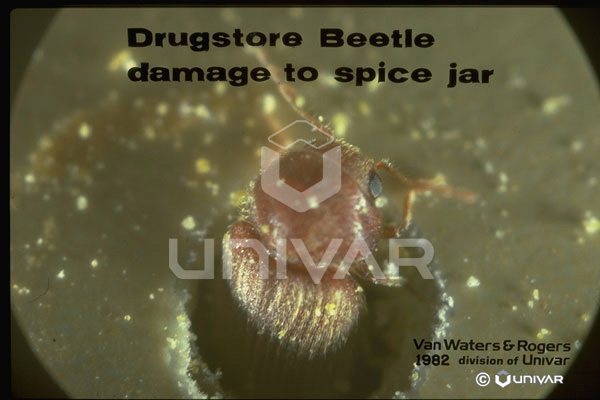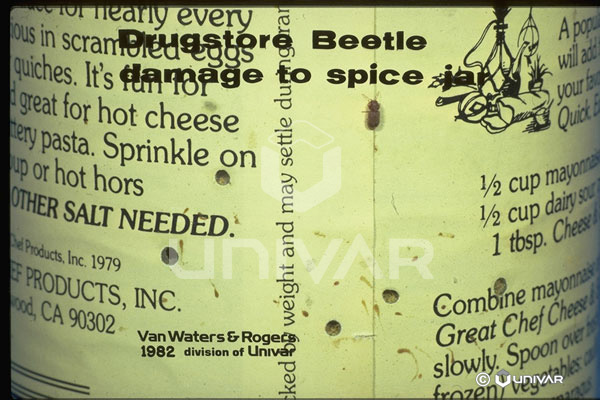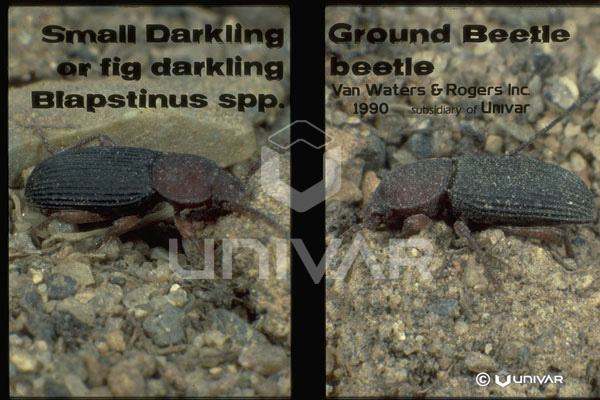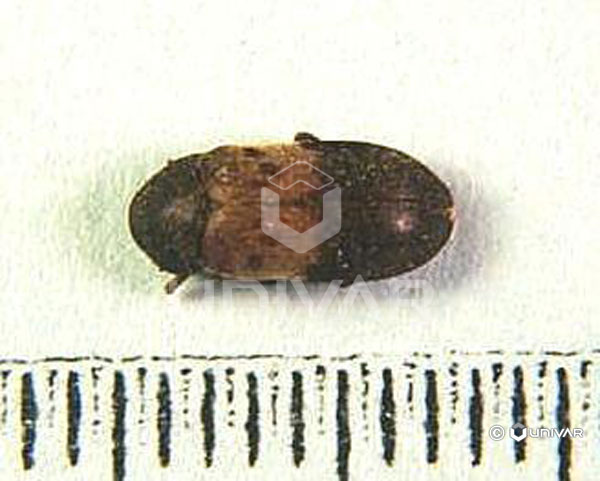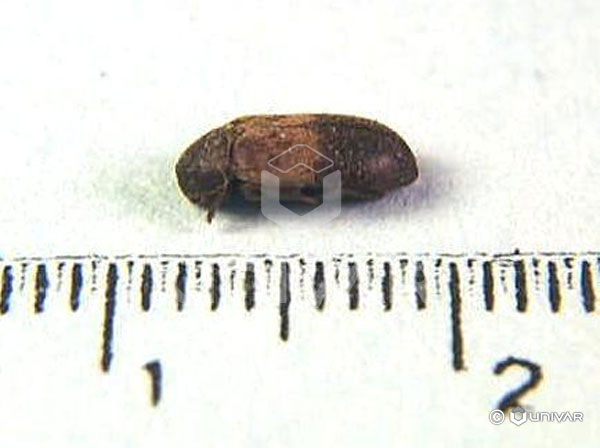
CARPET BEETLE
Common Name: Beetle – Carpet Beetle, Varied
Latin Name: Anthrenus verbasci
Common Family Name: Dermestid or skin beetles
Latin Family Name: Dermestidae
Origin: Not known for certain, as some literature suggests it is of European origin, while others suggest it may be native to North America, given that it is found in natural settings in the U.S. It is now found throughout the world.
Biology: These small beetles feed on a wide range of animal and plant products, causing severe pest problems in stored foods as well as on wool, hides, furs, feathers, or other materials with animal hair origins. They feed commonly on dead insects, and this may be the attraction to structures, where the beetles find leftovers in wasp nests, ant colonies, termite colonies, or bee hives, as well as accumulations in window sills. They are destructive to collections of insects or animals in museums. The length of time from egg to adult varies widely depending on temperature, humidity, and food quality but appears to average around 275 days, extending to almost 2 years in some circumstances. Adults live for around 1 month.
Identification: Carpet beetles in general are patterned in mottled, checkerboard, or wavy lines with black, white, gray, brown, or orange colors. They are only around 2 to 3 mm long, flattened from top to bottom, oval in shape, and very compact, with no separation between the prothorax and the elytra. The Varied Carpet Beetle is the most common in the western U.S., and it has the typical coloration and a “checkerboard” pattern, and the elytra meet at the posterior end with a straight juncture. The Furniture Carpet Beetle is identical to the Varied, but where the elytra meet there is a small concave notch, or “V” at the juncture. The larva of the Varied Carpet Beetle is brown, very hairy, with several enlarged tufts of hairs at its tail end, and is much wider at the tail end than at the front.
Characteristics Important in Control: Control of carpet beetles begins with storing susceptible food or fabric materials in containers that exclude adult insects. Prevention also centers around the removal of abandoned insects, rodents, or bird nests that may contain leftover skins, feathers, or hairs that the carpet beetle larvae feed on. If the infestation is in progress a thorough inspection to determine the source is needed, before the application of any pesticides. Pheromone traps exist that may facilitate the inspection and monitoring process.
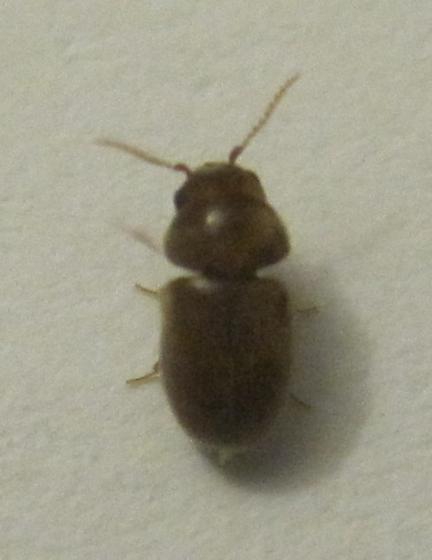
CIGARETTE BEETLE
Common Name: Beetle – Cigarette beetle
Latin Name: Lasioderma serricorne
Common Family Name: Deathwatch and drugstore beetles
Latin Family Name: Anobiidae
Other Names:
Origin: Thought to be native to Egypt, where it was found in the tomb of King Tut, this beetle now is found throughout the world.
Biology: Closely related to the Drugstore Beetle, the Cigarette Beetle will infest virtually any food product of vegetable origin, including baked goods and spices. It also is a severe pest of stored tobacco or tobacco products. It will bore into books, objects stuffed with straw or flax, dried flower arrangements, and other odd materials. The adult beetles can fly well, but they do not feed. Each female beetle can lay about 30 eggs, and the time from egg to adult is about 2.5 months, with up to 6 generations in one year in warm climates, and only 1 generation in colder climates. Adult beetles live for about one month.
Identification: Like the Drugstore Beetle, the Cigarette Beetle has its head strongly deflexed, or hidden under the prothorax, and when not walking it assumes somewhat of a “C” position. It has a more reddish color and is shiny, due to the very small pores on its exoskeleton. It is a very small beetle, usually around 2 mm long or less. The antennae are very different from its cousin, in that they are serrate, with all the segments the same size and shape, and without an enlarged club at the end.
Characteristics Important in Control: Preventing the pest from getting a foothold is extremely important, given the rapid reproductive rate and wide varieties of foods attacked. Proper stock rotation and storage practices are needed, including storage in a cool, dry condition if possible to slow down the reproductive rate of beetles that do enter. Monitoring commercial accounts with pheromone traps will help to discover when adult beetles enter, and help isolate the possible infested product.
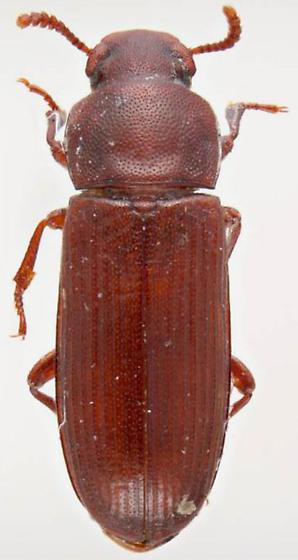
CONFUSED FLOUR BEETLE
Common Name: Beetle – Confused flour beetle
Latin Name: Tribolium confusum
Common Family Name: Darkling ground beetles
Latin Family Name: Tenebrionidae
Other Names: Bran bug
Origin: Native to Africa, and found in jars of grains placed in the tombs of Pharaohs around 2500 B.C. It now is found throughout the world and is more of a pest in the U.S. in the cooler climates than in the warmer states.
Biology: Very similar in appearance, biology, and habits to the Red Flour Beetle, the Confused flour beetle is a scavenger that feeds on virtually any vegetable-based food products, but it is unable to feed on whole, undamaged grains. It may occur in conjunction with the weevils that bore into grains, feeding on the grain once it is opened by the weevil. When present in great numbers they cause flour products to turn gray and distasteful and to mold more quickly. Flour and meal products are especially prone to infestation by flour beetles in general.
Identification: The Red Flour Beetle can fly, while the Confused cannot, even though both have well-developed wings. They are both elongated with roughly parallel sides, reddish color, and flattened top to bottom. The easiest differences to distinguish the two species are the antennae, where the Red Flour Beetle has a terminal club of 3 enlarged segments, and the sides of the prothorax of the Red are curved. In contrast, the Confused Flour Beetle has essentially straight sides on the prothorax and the antennae ends with a gradually enlarging club, not an abruptly enlarged one. Adults are about 2 mm long, and the larvae are the typical elongate, shiny, wormlike appearance of this family of beetles.
Characteristics Important in Control: Control of most stored food pest beetles relies on a combination of proper storage of products in cool, dry conditions and if possible in pest-proof containers, sanitation measures to remove or prevent spilled materials and dust accumulations, and monitoring with pheromone traps to determine when adult insect activity may begin in an account or to pinpoint the location of the infestation within a structure. Fumigation with either methyl bromide or aluminum phosphide will kill all stages of the beetles present in food, and ensure food products are pest-free as they go into storage.

DRUGSTORE BEETLE
Common Name: Beetle – Drugstore beetle
Latin Name: Stegobium paniceum
Common Family Name: Drugstore and Deathwatch beetles
Latin Family Name: Anobiidae
Other Names: Bread beetle
Origin: This beetle is found throughout the world as one of the most common and most destructive pests of food in storage. It is easily transported and spread in infested materials.
Biology: The Drugstore Beetle is perhaps the most common food pest in the U.S., infesting an extremely wide range of food materials. Virtually anything made from grains or vegetable materials is subject to attack, and an especially vulnerable area is spices and peppers. The adult beetle does not feed, but larvae may be found in flour, baked goods, pet foods, spices, coffee beans, and chocolate. The larvae have strong enough jaws to easily bore through packaging materials, including plastic jars, and into wooden materials such as cutting boards. It is related to some serious wood-boring insect pests and has been found in books, wooden shelving, and other wood objects in structures. The period from egg to adult insect takes less than 2 months, and there can be up to 6 generations per year.
Identification: This is a very small beetle, usually about 2.5 mm in length and with an elongated, cylindrical shape. It is a dull brown to grayish brown color, and under high magnification it can be seen that the exoskeleton is covered with large pores, giving it this dull appearance. When viewed from above the head is nearly hidden under the overhanging prothorax. It is very similar to the Cigarette Beetle, which is reddish and shinier, but the antenna of the Drugstore Beetle consists of a series of small basal segments followed by 3 much larger segments that make up the outer half of the antenna.
Characteristics Important in Control: Preventing the pest from getting a foothold is extremely important, given the rapid reproductive rate and wide varieties of foods attacked. Proper stock rotation and storage practices are needed, including storage in a cool, dry condition if possible to slow down the reproductive rate of beetles that do enter. Monitoring commercial accounts with pheromone traps will help to discover when adult beetles enter, and help isolate the possible infested product.
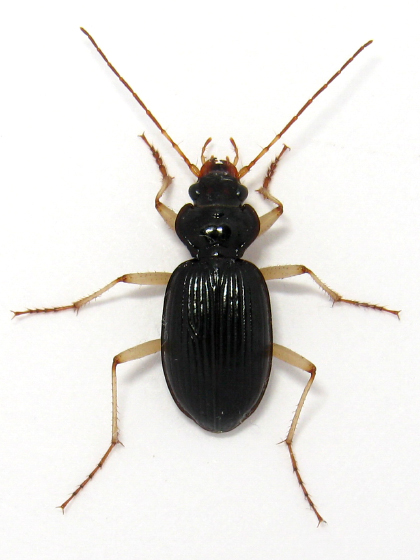
GROUND BEETLE
Common Name: Beetle – Darkling ground beetles
Latin Name: Cnemaplatia
Common Family Name: Darkling ground beetles
Latin Family Name: Tenebrionidae
Other Names:
Origin: A number of common native beetles that may incidentally be found in deteriorated food products or as accidental invaders of structures.
Biology: The family of Darkling ground beetles consists of many species that feed on decaying organic material, such as decaying vegetation and plant products. They are common residents in outdoor areas and may find their way into structures as Occasional Invaders, where they could feed on decaying food materials they may find stored in some forgotten place and in a condition unsuitable for human consumption. Their presence in a structure in numbers may even be considered an “indicator” of conditions or materials that should be cleaned or removed.
Identification: In general the smaller species of darkling ground beetles are dark, compact beetles with very hard exoskeletons. Their elytra are fully developed over the abdomen but most are incapable of flight, the elytra simply being fused together as a protective shell. Their antennae are medium length, filiform, and without an enlarged club at the end. Colors usually are dull black, dark gray, or dark brown.
Characteristics Important in Control: Since these beetles are not pests of palatable food they can be disposed of along with the discovered food source. They generally invade from the exterior and should be prevented as with most occasional invaders, by eliminating harborage sites outside, proper building maintenance and exclusion practices, and possible applications of a residual pesticide around the perimeter of the structure to intercept those that come to the structure.
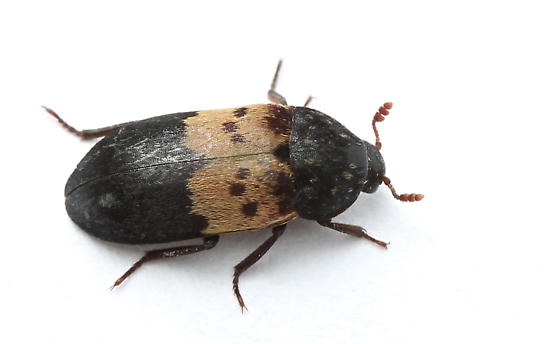
LARDER BEETLE
Common Name: Beetle – Larder Beetle
Latin Name: Dermestes lardarius
Common Family Name: Dermestid or skin beetles
Latin Family Name: Dermestidae
Other Names: Hide beetle
Origin: This beetle is found throughout the world, including in all of North America, where it is no longer found commonly as a food pest. This may be due partly to the better storage of meat products, which were often subjected to attack by this beetle.
Biology: Typical of the family Dermestidae, the Larder Beetle attacks a very wide variety of products, from meat to grain products, cheese, tobacco, cereal, and pet food products, as well as scavenging on dead insects and animal byproducts such as hair or wool. Females lay around 150 eggs in the food material or crevices nearby. The larvae feed until they have completed 5 to 6 molts and are ready to pupate, at which time they often move from the food and wander off to find a protected place to pupate, often boring into solid materials for this stage. Development from egg to adult normally takes about 45 days, and one generation per year is normal.
Identification: The Larder Beetle has distinct coloration on the adult, with the prothorax and posterior half of the elytra dark grayish brown, and the front half of the elytra yellow. Six dark spots appear on this yellow area. The shape is somewhat elongate and oval and around 8 mm long, fairly large for stored food pests.
Characteristics Important in Control: The Larder Beetle has become less of a pest of importance with the proper storage of meat products, although it also feeds on dead insect accumulations in structures, and its presence may be linked to this type of a source. Inspection to determine the source of the beetles and disposal of the infested material is necessary.

SAWTOOTHED GRAIN BEETLE
Common Name: Beetle – Sawtoothed grain beetle
Latin Name: Oryzaephilus surinamensis
Common Family Name: Flat bark beetles
Latin Family Name: Silvanidae
Other Names: The Latin name means “rice-loving from Surinam”
Origin: Possibly unknown, as this beetle has been found worldwide for many centuries.
Biology: The tiny grain beetles are members of a family of beetles that often are found under the loose bark of logs, where they are predators of other, smaller arthropods. The grain beetles sometimes are placed into a separate family called the Silvanidae, or “flat grain beetles”. These are all extremely flattened, narrow beetles that are capable of entering packages of food through the smallest of openings. They will feed on a wide range of vegetable-based food products, including rodent baits, but are not capable of attacking whole, unprocessed grains that are in good condition. The insects are relatively inactive in cool weather, and begin egg laying in the spring, the female laying up to 285 eggs. The period from egg to adult varies, but under optimal conditions of warmth and humidity, it can be completed in about 1 month. The adult of this species appears to be unable to fly, and they are extremely long-lived, with one record indicating an adult beetle survived for over 3 years.
Identification: The saw-toothed grain beetle is named for the row of saw-like projections along each side of the prothorax. It is identical to the Merchant Grain Beetle except for one characteristic. On the STGB the space between the eye and the back of the head is more than half the diameter of the eye, whereas on the MGB that space is very narrow, much less than half the diameter of the eye. Coloration ranges from light to dark brown, length is only about 2.5 mm, and it is a long, narrow beetle that is flattened from top to bottom.
Characteristics Important in Control: Good stock rotation and proper storage of food products in cool, dry conditions will inhibit the ability of this beetle to breed quickly. Cleanup of spilled material and debris in general also reduces the attraction of a structure, and proper maintenance of rodent baits, or the use only of paraffin block baits, eliminates this source as food for the beetles.

